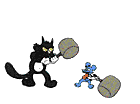billh wrote:
As for Elmer's/Sobo, DMQ used to recommend this (see The Pipers' Despair) but I believe he's gone off it now IIRC, thinks it affects the tone. Of course if it'a a choice between that, and binning the reed...
I can't tell any difference in the tone, but I have 65 year old ears and tinnitus in both ears now.
billh wrote:
If the E's like more volume above the staple (which the square shoulders can give), you might try using a slightly more open eye/thicker staple/etc. to achieve the same volume increase via the reed _thickness_ rather than width. This allows you to use the tapered-shoulder reed shape. In this case you want to avoid "gouging the tails" as such, using a more gradual tail thinning process instead, so that the thinner tails don't come at the expense of reducing the volume above the staple.
My reeds are as wide as I can make them and they will still go into the reed cap.
I sand my slips so that there is some "meat" left on the edges rather than aiming at a certain center thickness of the slip.
I use a rolled copper roofing flashing (0.020") staple with a 0.062" narrow dimention for the eye, and the chanter still wants the square design for the least pressure changes to play the Es in tune. I am currently playing a David Daye reed head which I soaked several weeks in neetsfoot oil, tied onto one of my staples and the sides are sealed nicely. I may have to change the bridle, however, as either octave A or octave B doesn't want to hold, depending on the location of the bridle, and I can hear a "buzz" in that note. I am hoping that placing the bridle fixed at the top of the wrap will cure this problem. At least, that cured some bad notes on some of my reeds.
It takes more care and time to adjust the lip opening with the fixed bridle, though, but I have had the best luck with the bridle being fixed and I haven't broken any of them (yet).
BTW, this reed is louder than the unsoaked head, but I did have to trim the lips some on that one, so it needs more scraping, I think.
billh wrote:
The latter (reduced volume above the staple) is a side-effect of gouging the tails without extending the thinning action into the blades. I think the 'chamber carving' approach can be seen as an attempt to have it both ways, e.g. thin tails without reduced volume. In this light, it's no surprise that several chamber carving methods seem to have evolved so that the tail-gouge and chamber have merged into one long excursion into the inner blades.
I don't gouge the tails or carve a chamber. I only chamfer the bark from the tails to make a smooth "step up" from the staple to the head.
billh wrote:
BK seems to achieve the right tail tension/thickness while maintaining good volume at the base by spreading this thinned area more gradually over the tails and "base" of the reed.
My reeds end up with a pretty thick base, but the scraped area has a "dip" or "scoop" where I have widened the V of the sanding to the U shape in order to bring in the hard bottom D.

